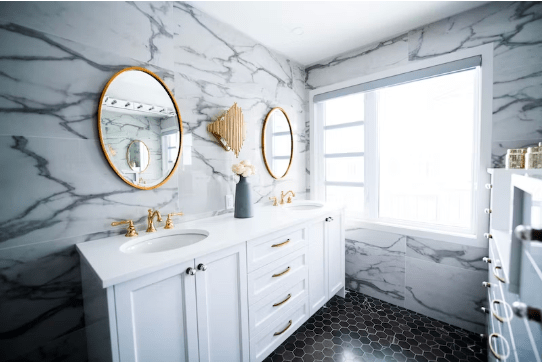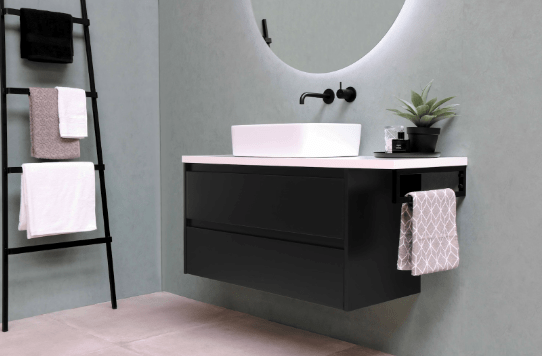In the realm of home design, the bathroom often holds a unique position – a private retreat that blends functionality with personal style. This space isn’t merely a utilitarian necessity; it serves as a sanctuary, a place where one begins and ends the day. Striking the perfect balance between form and function in bathroom design involves a mindful approach, considering not only aesthetic aspects but also practical needs. This guide will explore the art of achieving this equilibrium to create a bathroom that is both beautiful and efficiently designed.
Choosing the Right Tiles
The selection of tiles significantly contributes to the overall aesthetic and functional appeal of a bathroom. Tiles come in an array of materials, shapes, sizes, and colors, opening up a world of design possibilities. However, not all tiles are created equal. When selecting tiles, one must consider both their aesthetic appeal and their durability. Look for top bathroom tiles that can withstand high levels of moisture, heat, and regular wear and tear. For high-traffic areas and wet surfaces, choose tiles with high water resistance and slip-resistant properties. For walls or decorative accents, there’s more flexibility to prioritize style and color over durability. Taking the time to choose the right tiles can ensure your bathroom remains a functional and fashionable oasis for years to come.
Harnessing Natural Light
Capitalizing on natural light in a bathroom setting can dramatically enhance the overall ambiance of the space. Sunlight streaming through a window or skylight soothes the senses, illuminating the space with a warmth that artificial lighting can’t quite replicate. But beyond the aesthetics, incorporating plentiful amounts of natural light also serves a practical function. It can significantly reduce dependence on artificial lighting during daylight hours, offering potential energy savings. For privacy, consider frosted glass or top-down, bottom-up shades that allow light in while maintaining seclusion.
Material Selection
Choosing the right materials for your bathroom is a crucial aspect of balancing form and function. For flooring, stone or ceramic tiles are often favored due to their water-resistant properties and classic look. Countertops might be carved from quartz or granite, offering a balance of beauty and resilience. And for the walls, consider a balance between tiled areas and paint or wallpaper. Remember, each material you choose should not only align with your aesthetic preferences but also stand up to the moist, often humid conditions inherent in bathrooms.
Storage Solutions
A functional bathroom is one that offers ample storage for toiletries, towels, and other essentials. While it’s important to have these necessities within easy reach, clutter can detract significantly from the overall design. Integrating smart storage solutions is key — consider built-in shelving units, under-sink cabinets, and even shower niches to keep items organized. The right storage solutions will seamlessly blend into your bathroom’s design, enhancing its visual appeal while maintaining its functionality.
Maximizing Space
For many homeowners, space is a limited commodity in the bathroom. But with careful planning and utilization of every inch, even small bathrooms can feel open and airy. Consider installing a pedestal sink to free up floor space or opting for wall-mounted faucets to maximize counter space. Additionally, using light colors for walls and fixtures can create an illusion of more space. And don’t forget about vertical storage – utilizing wall shelves or a tall cabinet can add much-needed storage without taking up valuable floor space.
Bringing in Personal Touches
While functionality and practicality are crucial components of bathroom design, it’s essential to infuse your personal style into the space as well. Choose colors that resonate with you and incorporate elements like artwork, decorative accents, or plants to make the space feel more inviting and reflective of your personality. The key is to strike a balance between these personal touches and functionality – accessories should enhance, not clutter, the space.
Considering Sustainability
In today’s environmentally conscious world, integrating sustainable elements into your bathroom design can be both aesthetically pleasing and functionally responsible. Consider using low-flow faucets and showerheads, LED lighting, or even solar-powered heaters. Materials, too, can be sustainable – recycled glass tiles or reclaimed wood cabinets are both stylish and eco-friendly options. Incorporating these elements can not only lessen your bathroom’s environmental impact but also save you money in the long run through energy and water efficiency.

Designing a bathroom that balances form and function is no small feat. It calls for a careful consideration of materials, a strategic approach to lighting and space, intelligent storage solutions, and an infusion of personal style. And increasingly, it also involves a nod to sustainability. But the reward is significant: a bathroom that serves as a practical space for daily routines and a personal retreat for relaxation. Remember, the key is balance, ensuring that each decision enhances both the visual appeal and the functionality of the space. With thoughtful planning and a keen eye for design, you can create a bathroom that truly marries form and function, becoming a haven within your home.


